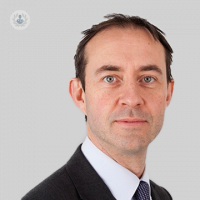Putting the spring back in your step: Could forefoot reconstruction surgery help you?
Escrito por:Forefoot reconstruction surgery can be the answer to troublesome bunions, pain under foot and restricted movement caused by arthritic inflammation of the toe joint. Leading consultant orthopaedic surgeon Mr Paul Hamilton, who is specialist in foot and ankle surgery, gives expert insight into forefoot reconstruction procedures and the relief various techniques can offer patients in this illuminating article.

What is the purpose of forefoot reconstruction surgery?
The term forefoot reconstruction encompasses multiple different procedures for a variety of conditions; from minor deformity of the big toe such as a bunion, to significant deformity of multiple toes with severe arthritis (as seen in rheumatoid arthritis) which is often accompanied by pain under the foot (metatarsalgia).
The aim of surgery is to provide a functioning, pain free foot which can be achieved by realignment of bones, offloading of the painful joint, straightening of lesser toes and occasionally fusion (excision and fixation) of painful arthritic joints.
Who is a good candidate for forefoot reconstruction surgery?
Patients with pain in the big toe either due to a bunion, growth of bone or arthritis can be considered for surgery. This may be accompanied by pain under the ball of the foot and lesser toe deformity (clawing) and occasionally fifth toe bunionettes (pain on the outside of the little toe).
In some cases, the big toe may not be painful, even in the presence of arthritis or a bunion of the big toe and rather the ball of the foot or the lesser toes are causing discomfort. All patients should consider non-surgical treatment initially, such as shoe wear change, bunion protectors, toe spacers and insoles.
Callosities or corns (areas of hard skin) can often be treated by offloading of a joint by insoles or prevention of rubbing accompanied by excision by a chiropodist or podiatrist. If the pain continues to affect a patient’s quality of life then surgery can be considered.
What happens during forefoot reconstruction surgery?
The surgery depends on the condition being treated. To treat a bunion, for instance, surgery may involve straightening of the big toe or straightening of lesser toes to treat claw toes. Whereas overloading the joint may be required to treat metatarsalgia or fusion of the joints for arthritis or possibly a combination of the above.
The techniques depend on the condition and may involve incisions over the affected areas or small holes (minimally invasive surgery). Screws or plates may be used to stabilise the surgery and usually do not require removal. Small wires may be used to straighten the toes and if required can be removed four to six weeks later without the need for further surgery.
What can patients expect from the surgery and the following recovery period?
The surgery is usually performed under anaesthetic, accompanied by pain relieving injections to minimise the post-operative discomfort. It is performed as a day case (home the same day) and patients are given a bandage and a special shoe. There is usually a review after two and six weeks and the bandage and shoe are required for that time.
It is important to elevate the foot in the first two weeks, but walking can start immediately in the majority of patients. Depending on the type of surgery, you may be given exercises for the foot at two weeks. At six weeks, the majority will discard the shoe and bandage and be able to fit into trainers.
Can you have normal use of the foot after recovery from a reconstruction procedure?
The aim of surgery is to obtain a functioning, pain free foot that can fit into normal shoes and allow patients to return back to previous levels of activity. This can be achieved in the majority of cases, but very much depends of the extent of the problem. Prior to surgery all patients should be assessed and any decision to undergo surgery should be discussed with an orthopaedic surgeon specialising in foot surgery.
Mr Hamilton is one of the UK’s leading experts in foot and ankle surgery. If you are considering a forefoot reconstruction procedure and would like to discuss your options, don’t hesitate visit Mr Hamilton’s Top Doctors profile to book a consultation.


